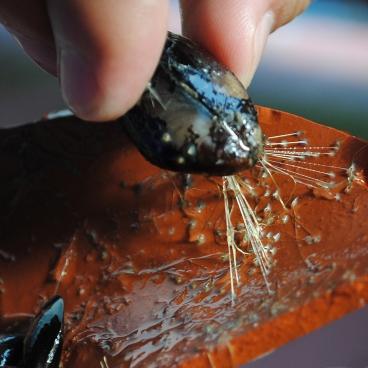MIT Researchers Study Mussels to Develop New Medical, Industrial Materials
August 21, 2013

More and more scientists are looking to nature for inspirations for technology, and now mussels -- those tasty mollusks that cling to the sides of rocks -- could be the impetus for new types of adhesive materials thanks to the work of researchers at MIT.
MIT research scientist Zhao Qin and professor of civil and environmental engineering Markus Buehler have been studying mussels they've collected in the Boston Harbor to observe how they cling to surfaces via very thin filaments called byssus threads. Even though these filaments are very fine and mussels are sometimes pummeled by waves as they hold on to rocks, they almost never fall off. This inspired Qin and Buehler to find out the secret to this impressive and tenacious strength.

"Many related questions arise once you see this attachment: How do they glue the threads to the rock under water? How are the threads able to absorb the impact force?" Qin told Design News in an email. "Those relate to engineering problems such as how to glue two different materials together and how to design a structure with the ability to absorb impact force. Here, we hope to learn from this mussel adhesion and apply the knowledge for material design."
Studying mussels for keys to developing sticky materials is not new, as scientists have already been studying the glue that holds the byssus threads to surfaces to observe its strength under pressure. In fact, that is how the research of Qin and Buehler began two years ago, but eventually they shifted their focus to study the threads themselves, Qin told us. "We found [the glue's] strength is not high enough for impact loading, and that is why we focus on the study of the composition and organization of the mussel threads," he said.
To collect mussels, researchers placed an underwater cage in the harbor with glass, ceramics, wood, and clay in it, items to which the creatures attached themselves. Once collected, researchers brought the mussels back to the lab and tested their strength by mounting the mollusks, their threads, and substrates in a tensile machine that pulled on them with controlled deformation and then recorded the applied force during this process.
During their research -- the findings of which are published in an article online in Nature Communications -- Qin and Buehler discovered the composition of the threads -- a combination of soft, stretchy material on one end and much stiffer material on the other. Both materials are made of a protein similar to collagen, which also comprises skin, bone, cartilage, and tendons.
The ratio of these materials -- 80 percent stiff material to 20 percent soft material -- and their distribution seems to be key to their adhesion, researchers found. They performed computer simulations and tested different ratios of materials to test the strength of other combinations, but found that ultimately the 80:20 ratio lead to the smallest reaction force on the part of the thread. The stiffness of the thread also prevents the mussels from being pulled out too far by waves, which also limits their exposure to harm. "The combination of the two materials in an organized way makes it very difficult to fracture under tension and its performance is far beyond any of those two raw materials," Qin said.
These findings could provide the basis for new designs in synthetic materials that also must cling securely in places where there is pressure or force being exerted back on them, Qin said:
They could be applied for materials to attach instruments to buildings, or sensors to underwater vehicles or sensing equipment in extreme conditions. They also could have biomedical usages such as surgical sutures used in blood vessels or tendons that are subjected to vibrating and dynamic forces, and their reliability are very critical for those conditions.
Researchers are currently working on the development of materials in the lab that have this soft-to-stiff ratio through the use of 3D printing, Qin added.
The Office of Naval Research and the National Science Foundation supported the research.
Related posts:
About the Author(s)
You May Also Like



